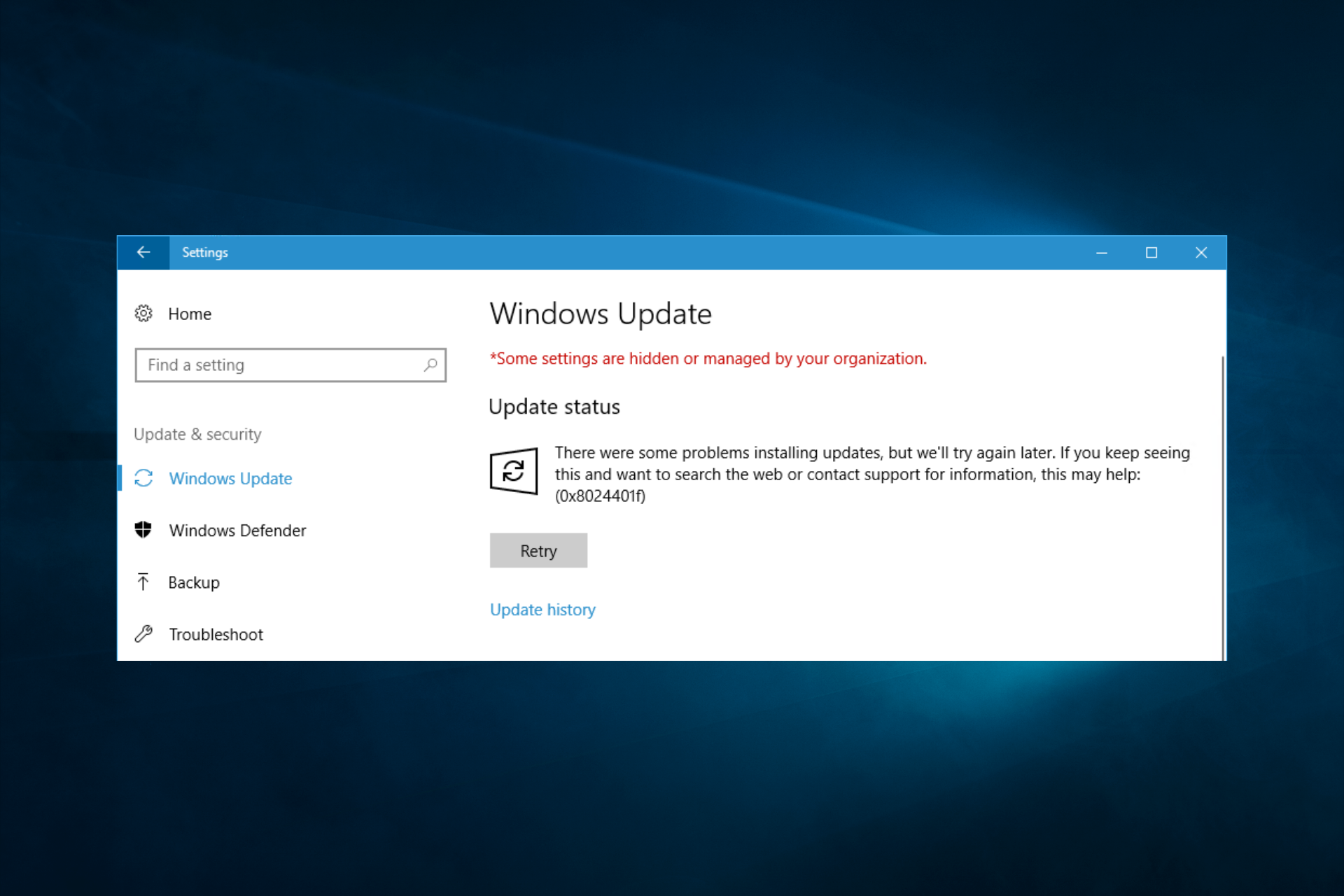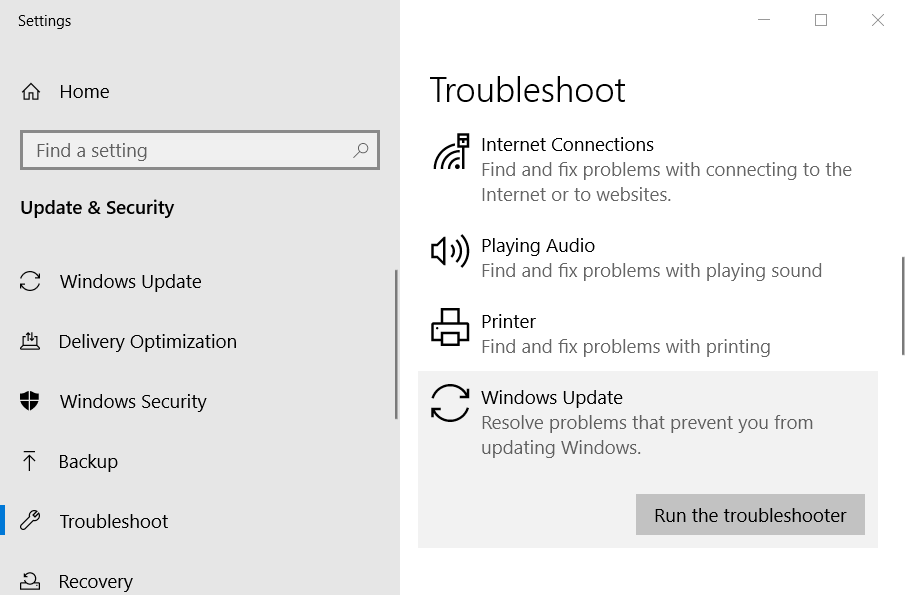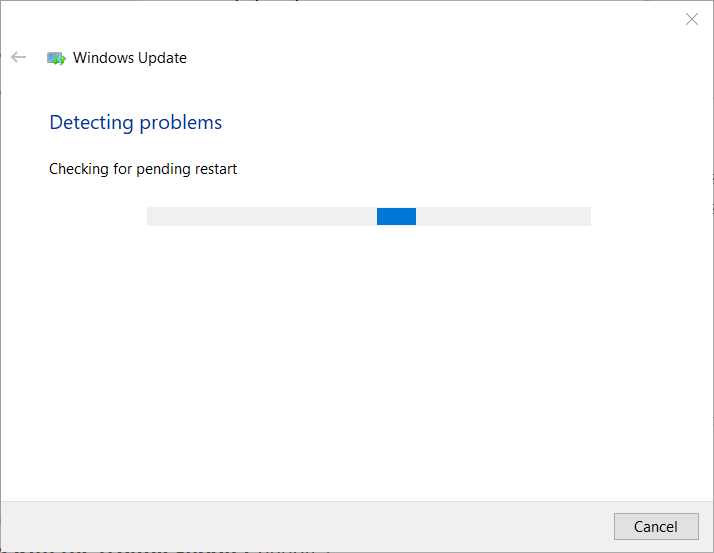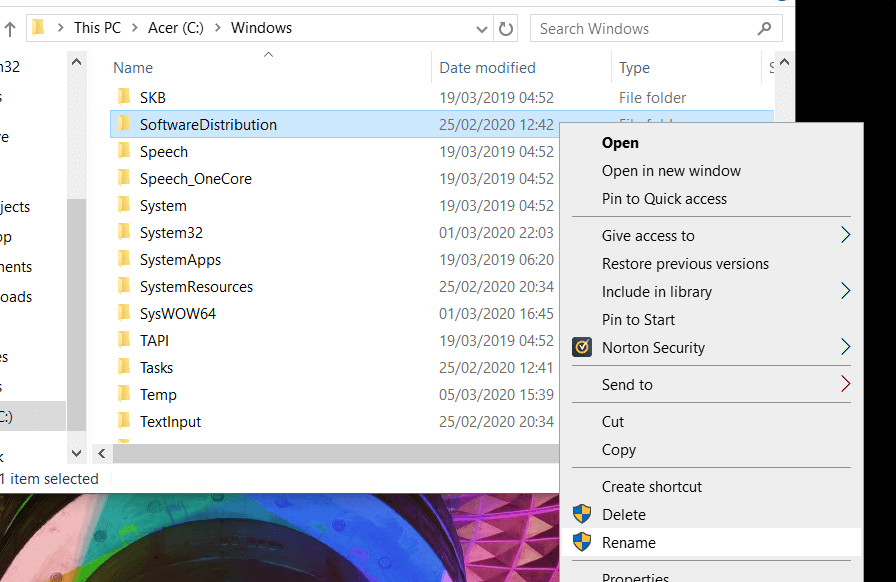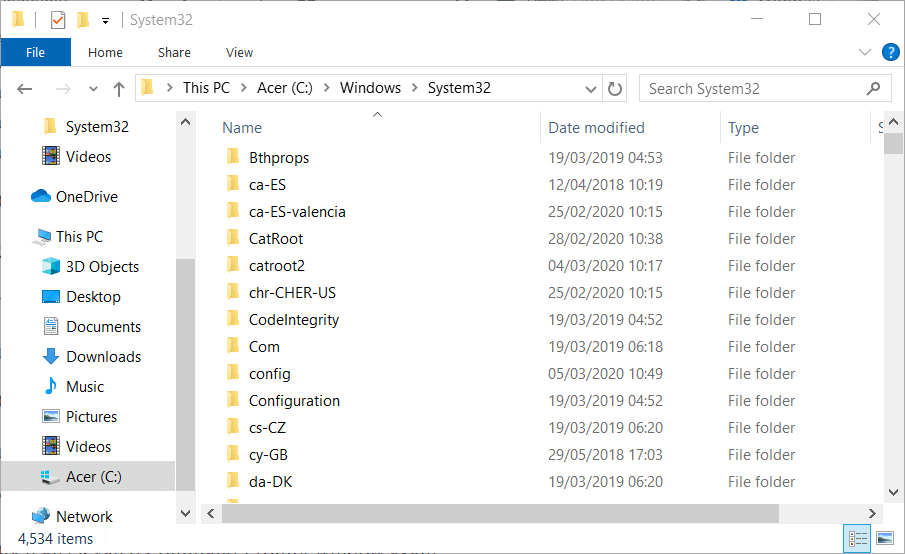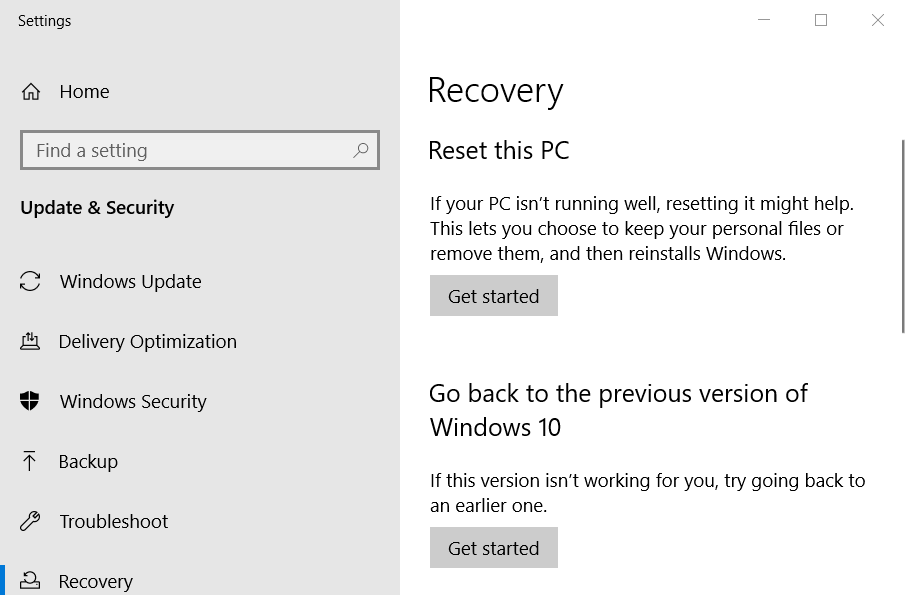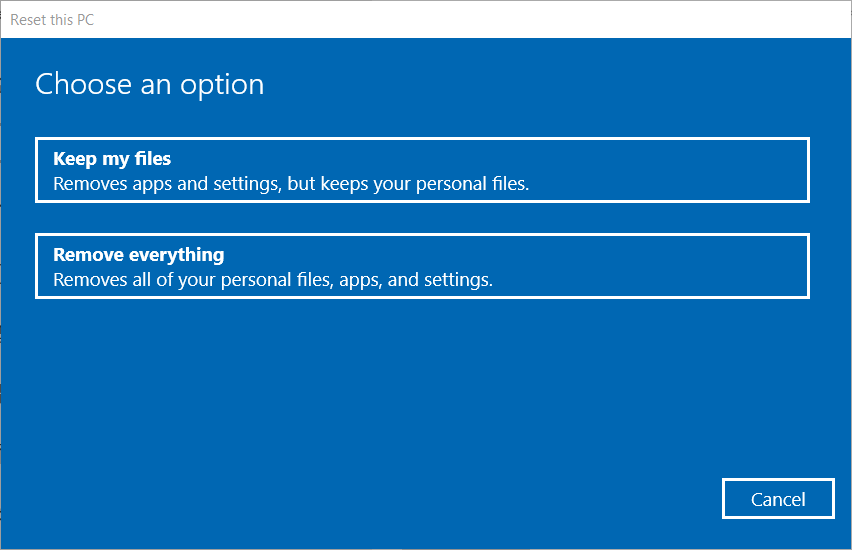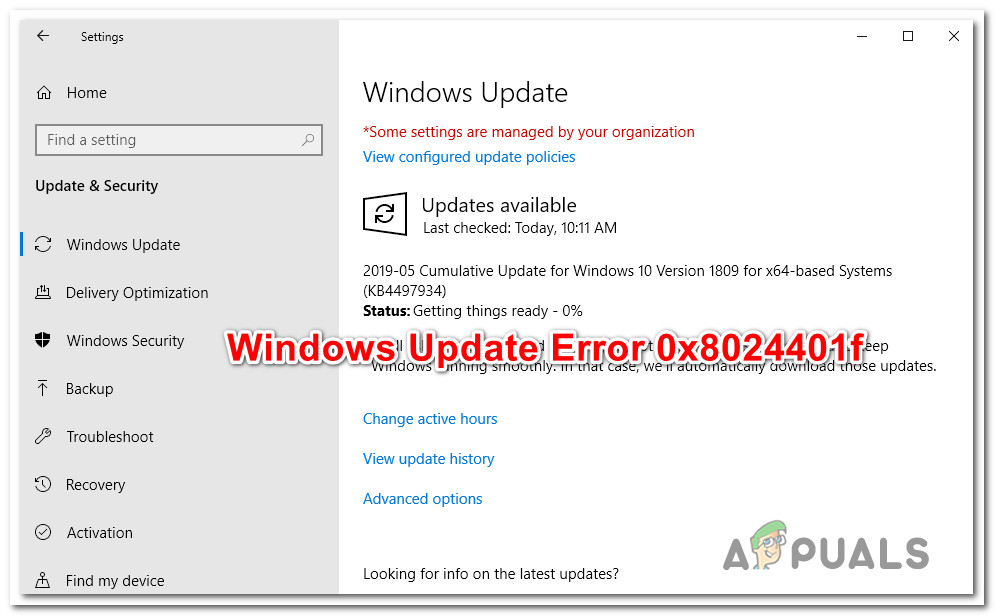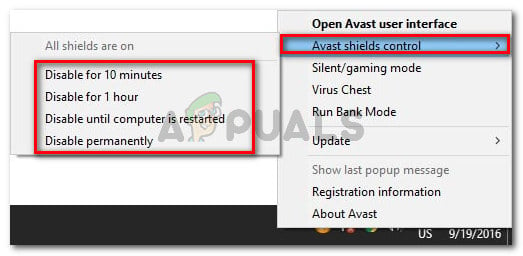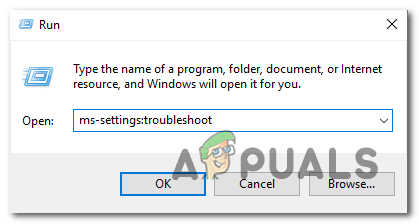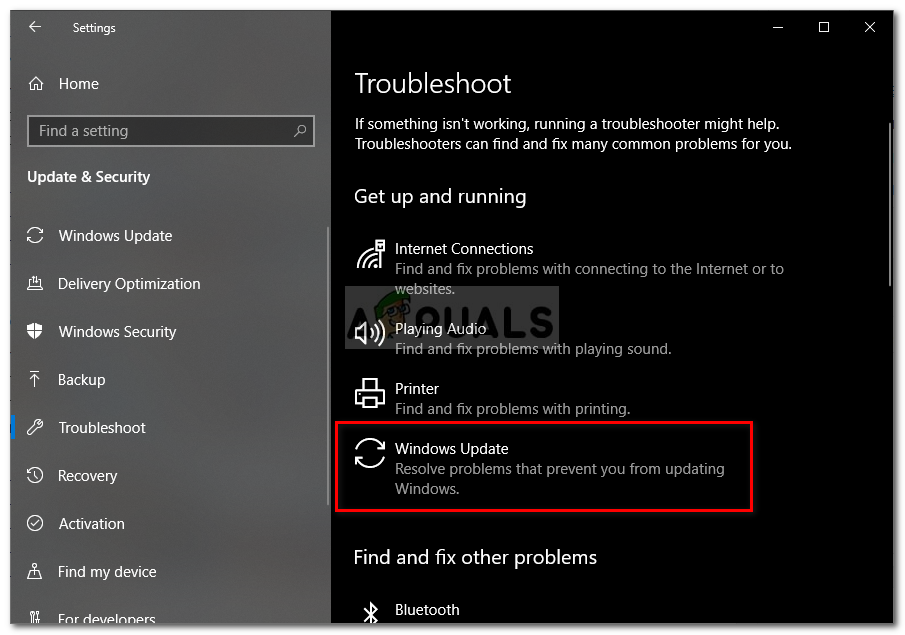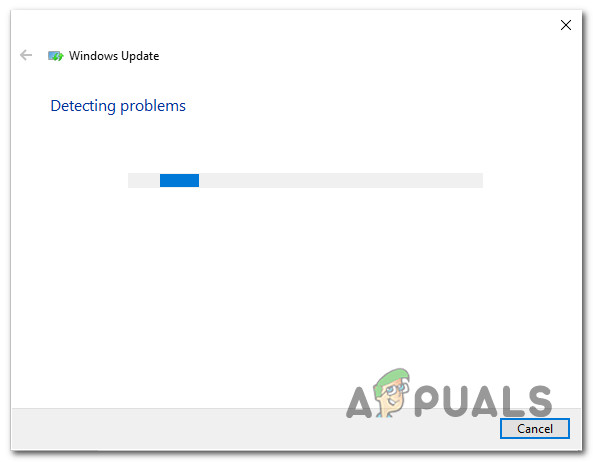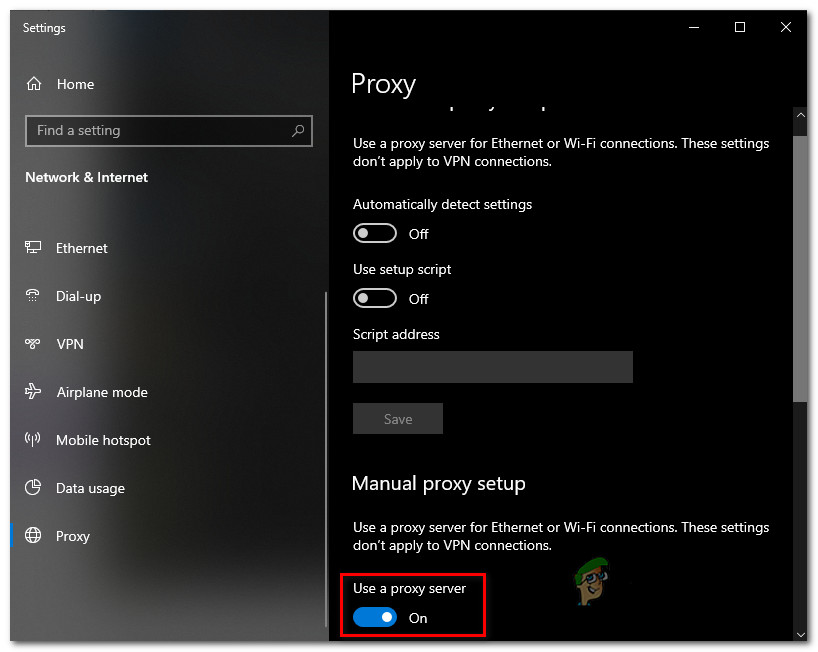-
Вопрос
-
I’m using windows 7, and WSUS to get my updates. windows update detects the updates from WSUS but when i try downloading them, i’m facing this error code 8024401F.
Note other windows 7 machines have no problem with the same configuration.
Все ответы
-
but when i try downloading them, i’m facing this error code 8024401F.
This is an HTTP 500 error, and generally indicates that the serer has some intenal issue impacting the response to the request. Since this is only client experiencing this issue, it suggests that the problem may be a bad request submitted that the server cannot properly respond to.
It would be useful to see the full detection event, with the error in context.
Lawrence Garvin, M.S., MCITP:EA, MCDBA, MCSA
Principal/CTO, Onsite Technology Solutions, Houston, Texas
Microsoft MVP — Software Distribution (2005-2010)
My MVP Profile: http://mvp.support.microsoft.com/profile/Lawrence.Garvin
My Blog: http://onsitechsolutions.spaces.live.com -
hi lawrence,
This issue is getting frustrating to me, i would appreciate your help. Please let me know what information you need in details and from where should i get them.
Thanks,
-
hi lawrence,
This issue is getting frustrating to me, i would appreciate your help. Please let me know what information you need in details and from where should i get them.
Thanks,
Uhhh…. I thought I asked that already . . .
>> It would be useful to see the full detection event, with the error in context.
Presumably you’re already familiar with the WindowsUpdate.log — I’m assuming that’s where your reference to the error code (0x8024401F) is coming from.
Lawrence Garvin, M.S., MCITP:EA, MCDBA, MCSA
Principal/CTO, Onsite Technology Solutions, Houston, Texas
Microsoft MVP — Software Distribution (2005-2010)
My MVP Profile: http://mvp.support.microsoft.com/profile/Lawrence.Garvin
My Blog: http://onsitechsolutions.spaces.live.com -
I am getting the same error on Windows SBS 2008 server which in turn will not update and allow the clients to get the update — The actual error is «WindowsUpdate_8024401F» «WindowsUpdate_dt000» and I can not find reference to it anywhere.
I don’t quite understand what you mean by «full detection event, with the error in context» but I have found these errors in the event log.
The update cannot be started because the content sources cannot be accessed. Fix the errors and try the update again.
Context: Application ‘Search’, Catalog ‘index file on the search server Search’
The start address <sts3s://XXX.mywebsite.com:987/contentdbid={b0bf23e2-2ef2-4eef-8e0b-e29beeea0ae2}> cannot be crawled.
Context: Application ‘Search index file on the search server’, Catalog ‘Search’
Details:
Access is denied. Verify that either the Default Content Access Account has access to this repository, or add a crawl rule to crawl this repository. If the repository being crawled is a SharePoint repository, verify that the account you are using has «Full
Read» permissions on the SharePoint Web Application being crawled. (0x80041205) -
I am also getting the same error in Windows Server 2008 standard.
But the strange thing is that, after showing this error for months, windows got updated on last Dec 2010. Again after that single day, it is showing the same error. As far as I remember I haven’t made any changes.
-
Предложено в качестве ответа
1 сентября 2017 г. 14:46
-
Предложено в качестве ответа
-
I am also getting the same error in Windows Server 2008 standard.
But the strange thing is that, after showing this error for months, windows got updated on last Dec 2010. Again after that single day, it is showing the same error. As far as I remember I haven’t made any changes.
The same request applies.. Post The Log Entries showing the client’s detection event. Without logs, I haven’t got a clue what’s happening.
Lawrence Garvin, M.S., MCITP:EA, MCDBA, MCSA
Principal/CTO, Onsite Technology Solutions, Houston, Texas
Microsoft MVP — Software Distribution (2005-2011)
My MVP Profile: http://mvp.support.microsoft.com/profile/Lawrence.Garvin
My Blog: http://onsitechsolutions.spaces.live.com -
Hi Everyone,
I was facing similar issue but couldnt find solution anywhere.
As i found that this is dns error i did one step and solved the issue for me.
Please try ipconfig /flushdns and then try updates staraightaway.
Tell me if that helped.
Please mark as answer if that helps. that will help others as well
Tx n Re, NSB Please click the Check Mark As Answered On This Page If this post helps to resolve your issue as it helps others.
-
Предложено в качестве ответа
v-2nbatt
18 мая 2011 г. 10:40 -
Отменено предложение в качестве ответа
Lawrence Garvin
24 мая 2013 г. 17:39
-
Предложено в качестве ответа
-
Dear all
i’m also facing seam issue with Windows Server 2008 standard and couldn’t find any solution
and i’m also try ipconfig /flushdns but nothing happened
i’m totally tired don’t know what to do
any one can help
Mr v-2nbatt did you find any solution ?
kind regerds
-
Hi Ahmed,
As stated above by Lawrence, we need to take a look at the logs in order to help you. Try this:
1) From a command prompt on the server with issues, type «wuauclt /detectnow», without the quotes. This kicks off a checkin with your WSUS server.
2) On this same server, navigate to your Windows directory (usually c:\windows). There is a file there called ‘windowsupdate.log’. Open this file in your text editor, then look for the lines with a timestamp that matches the time when you performed
step 1. Copy all the lines with this timestamp and put them into a reply here so we can hopefully see where the error is.Once we see that, we might be able to help you out.
Hope that helps,
John
-
Hi Ahmed,
As stated above by Lawrence, we need to take a look at the logs in order to help you. Try this:
1) From a command prompt on the server with issues, type «wuauclt /detectnow», without the quotes. This kicks off a checkin with your WSUS server.
2) On this same server, navigate to your Windows directory (usually c:\windows). There is a file there called ‘windowsupdate.log’. Open this file in your text editor, then look for the lines with a timestamp that matches the time when you performed
step 1. Copy all the lines with this timestamp and put them into a reply here so we can hopefully see where the error is.Once we see that, we might be able to help you out.
Hope that helps,
John
Hi John
I am having the same issue, I run a small network (1 x SBS 2008, 1 x Server 2003 and 3 PCs — 2 x XP Pro and 1 x Windows 7 Pro). I appear to be having the same issues as mentioned above. Although updates seem to be work find for
the XP machines and the Server 2003. To confirm I only get the error on the SBS 2008 and the Windows 7 Machine.I have followed your instruction above and the following are from the windowsupdate.log….. I hope you can help!!
2011-07-15 15:56:12:422 264 914 AU Triggering AU detection through DetectNow API
2011-07-15 15:56:12:422 264 914 AU Triggering Online detection (non-interactive)
2011-07-15 15:56:12:422 264 2614 AU #############
2011-07-15 15:56:12:422 264 2614 AU ## START ## AU: Search for updates
2011-07-15 15:56:12:422 264 2614 AU #########
2011-07-15 15:56:12:422 264 2614 AU <<## SUBMITTED ## AU: Search for updates [CallId = {3D74536C-D5C0-46AE-A2E4-732392302407}]
2011-07-15 15:56:12:422 264 dd0 Agent *************
2011-07-15 15:56:12:422 264 dd0 Agent ** START ** Agent: Finding updates [CallerId = AutomaticUpdates]
2011-07-15 15:56:12:422 264 dd0 Agent *********
2011-07-15 15:56:12:422 264 dd0 Agent * Online = Yes; Ignore download priority = No
2011-07-15 15:56:12:422 264 dd0 Agent * Criteria = «IsInstalled=0 and DeploymentAction=’Installation’ or IsPresent=1 and DeploymentAction=’Uninstallation’ or IsInstalled=1 and DeploymentAction=’Installation’ and RebootRequired=1
or IsInstalled=0 and DeploymentAction=’Uninstallation’ and RebootRequired=1»
2011-07-15 15:56:12:422 264 dd0 Agent * ServiceID = {3DA21691-E39D-4DA6-8A4B-B43877BCB1B7} Managed
2011-07-15 15:56:12:422 264 dd0 Agent * Search Scope = {Machine}
2011-07-15 15:56:12:422 264 dd0 Setup Checking for agent SelfUpdate
2011-07-15 15:56:12:422 264 dd0 Setup Client version: Core: 7.4.7600.226 Aux: 7.4.7600.226
2011-07-15 15:56:12:422 264 dd0 Misc Validating signature for C:\Windows\SoftwareDistribution\SelfUpdate\wuident.cab:
2011-07-15 15:56:12:438 264 dd0 Misc Microsoft signed: Yes
2011-07-15 15:56:12:438 264 dd0 Misc WARNING: WinHttp: SendRequestToServerForFileInformation failed with 0x801901f4
2011-07-15 15:56:12:438 264 dd0 Misc WARNING: WinHttp: ShouldFileBeDownloaded failed with 0x801901f4
2011-07-15 15:56:12:438 264 dd0 Misc WARNING: WinHttp: SendRequestToServerForFileInformation failed with 0x801901f4
2011-07-15 15:56:12:454 264 dd0 Misc WARNING: WinHttp: ShouldFileBeDownloaded failed with 0x801901f4
2011-07-15 15:56:12:454 264 dd0 Misc WARNING: WinHttp: SendRequestToServerForFileInformation failed with 0x801901f4
2011-07-15 15:56:12:454 264 dd0 Misc WARNING: WinHttp: ShouldFileBeDownloaded failed with 0x801901f4
2011-07-15 15:56:12:454 264 dd0 Misc WARNING: WinHttp: SendRequestToServerForFileInformation failed with 0x801901f4
2011-07-15 15:56:12:454 264 dd0 Misc WARNING: WinHttp: ShouldFileBeDownloaded failed with 0x801901f4
2011-07-15 15:56:12:454 264 dd0 Misc WARNING: DownloadFileInternal failed for
http://SBS01:8530/selfupdate/wuident.cab: error 0x801901f4
2011-07-15 15:56:12:454 264 dd0 Setup WARNING: SelfUpdate check failed to download package information, error = 0x8024401F
2011-07-15 15:56:12:454 264 dd0 Setup FATAL: SelfUpdate check failed, err = 0x8024401F
2011-07-15 15:56:12:454 264 dd0 Agent * WARNING: Skipping scan, self-update check returned 0x8024401F
2011-07-15 15:56:12:938 264 dd0 Agent * WARNING: Exit code = 0x8024401F
2011-07-15 15:56:12:938 264 dd0 Agent *********
2011-07-15 15:56:12:938 264 dd0 Agent ** END ** Agent: Finding updates [CallerId = AutomaticUpdates]
2011-07-15 15:56:12:938 264 dd0 Agent *************
2011-07-15 15:56:12:938 264 dd0 Agent WARNING: WU client failed Searching for update with error 0x8024401f
2011-07-15 15:56:12:938 264 2138 AU >>## RESUMED ## AU: Search for updates [CallId = {3D74536C-D5C0-46AE-A2E4-732392302407}]
2011-07-15 15:56:12:938 264 2138 AU # WARNING: Search callback failed, result = 0x8024401F
2011-07-15 15:56:12:938 264 2138 AU # WARNING: Failed to find updates with error code 8024401F
2011-07-15 15:56:12:938 264 2138 AU #########
2011-07-15 15:56:12:938 264 2138 AU ## END ## AU: Search for updates [CallId = {3D74536C-D5C0-46AE-A2E4-732392302407}]
2011-07-15 15:56:12:938 264 2138 AU #############
2011-07-15 15:56:12:938 264 2138 AU Need to show Unable to Detect notification
2011-07-15 15:56:12:938 264 2138 AU AU setting next detection timeout to 2011-07-15 15:49:03Best regards
Luke
-
2011-07-15 15:56:12:454 264 dd0 Misc WARNING: DownloadFileInternal failed for
http://SBS01:8530/selfupdate/wuident.cab: error 0x801901f4This is an HTTP 404 error trying to find the selfupdate services on the WSUS server.
Either WSUS is not installed on the SBS server, or the ‘selfupdate’ virtual directory has «Gone Missing».
Please open IIS on your SBS2008 server and determine if there is a v-root named «WSUS Administrator».
If so, open that node and determine if there is a v-dir named «selfupdate».
Lawrence Garvin, M.S., MCITP:EA, MCDBA, MCSA
Principal/CTO, Onsite Technology Solutions, Houston, Texas
Microsoft MVP — Software Distribution (2005-2011)
My MVP Profile: http://mvp.support.microsoft.com/profile/Lawrence.Garvin
My Blog: http://onsitechsolutions.spaces.live.com -
2011-07-15 15:56:12:454 264 dd0 Misc WARNING: DownloadFileInternal failed for
http://SBS01:8530/selfupdate/wuident.cab: error 0x801901f4This is an HTTP 404 error trying to find the selfupdate services on the WSUS server.
Either WSUS is not installed on the SBS server, or the ‘selfupdate’ virtual directory has «Gone Missing».
Please open IIS on your SBS2008 server and determine if there is a v-root named «WSUS Administrator».
If so, open that node and determine if there is a v-dir named «selfupdate».
Lawrence Garvin, M.S., MCITP:EA, MCDBA, MCSA
Principal/CTO, Onsite Technology Solutions, Houston, Texas
Microsoft MVP — Software Distribution (2005-2011)
My MVP Profile: http://mvp.support.microsoft.com/profile/Lawrence.Garvin
My Blog: http://onsitechsolutions.spaces.live.comHi Lawrence
Thanks for your quick response!
I have checked on the server and there appears to be both a v-root named WSUS Administrator and also a v-dir named selfupdate. I have uploaded a JPEG screenshot here:
http://intellivault.co.uk/images/screen-shot.jpg if this helps.I have also check this folder (C:\Program Files\Update Services\Selfupdate) and found the wuident.cab file (that was indicated in the log) there.
Not sure if it is relevant but when I opened IIS on the server I noticed that I had 2 managers available, IIS 6 and IIS 7. When I opened IIS 6 the only option available where
for FTP Sites and that appears to be in a stopped state.Also, this may or may not be related but I also have a problem with the internal website the server sets as the default home page for new domain PCs (I think this is its built
in SharePoint site), this page doesn’t load (HTTP 500 Internal Server Error), the internal address is
http://companyweb/ — this is not a major issue as we dont use it anyway, I only mention it in case it is relevant the windows update problem.Any further advice you have would be greatly appreciated.
Best regards
Luke
-
Предложено в качестве ответа
Luke Shepherd
18 июля 2011 г. 16:23 -
Отменено предложение в качестве ответа
Luke Shepherd
18 июля 2011 г. 16:23
-
Предложено в качестве ответа
-
2011-07-15 15:56:12:454 264 dd0 Misc WARNING: DownloadFileInternal failed for
http://SBS01:8530/selfupdate/wuident.cab: error 0x801901f4This is an HTTP 404 error trying to find the selfupdate services on the WSUS server.
Either WSUS is not installed on the SBS server, or the ‘selfupdate’ virtual directory has «Gone Missing».
Please open IIS on your SBS2008 server and determine if there is a v-root named «WSUS Administrator».
If so, open that node and determine if there is a v-dir named «selfupdate».
Lawrence Garvin, M.S., MCITP:EA, MCDBA, MCSA
Principal/CTO, Onsite Technology Solutions, Houston, Texas
Microsoft MVP — Software Distribution (2005-2011)
My MVP Profile: http://mvp.support.microsoft.com/profile/Lawrence.Garvin
My Blog: http://onsitechsolutions.spaces.live.comHi Lawrence
Thanks for your quick response!
I have checked on the server and there appears to be both a v-root named WSUS Administrator and also a v-dir named selfupdate. I have uploaded a JPEG screenshot here:
http://intellivault.co.uk/images/screen-shot.jpg if this helps.I have also check this folder (C:\Program Files\Update Services\Selfupdate) and found the wuident.cab file (that was indicated in the log) there.
Not sure if it is relevant but when I opened IIS on the server I noticed that I had 2 managers available, IIS 6 and IIS 7. When I opened IIS 6 the only option available where
for FTP Sites and that appears to be in a stopped state.Also, this may or may not be related but I also have a problem with the internal website the server sets as the default home page for new domain PCs (I think this is its built
in SharePoint site), this page doesn’t load (HTTP 500 Internal Server Error), the internal address is
http://companyweb/ — this is not a major issue as we dont use it anyway, I only mention it in case it is relevant the windows update problem.Any further advice you have would be greatly appreciated.
Best regards
Luke
I have found a fix!!
I found this page:
http://support.microsoft.com/kb/942062 and followed method 1:Method 1
<script type=»text/javascript»>// <![CDATA[ loadTOCNode(2, ‘resolution’); ]]></script> To resolve this problem, follow these steps:
- Start IIS Manager. To do this, click Start, click
Run, type inetmgr.exe, and then click OK. - In IIS Manager, expand <var>server name</var>, expand
Web sites, and then click the Web site that you want to modify. - In Features view, double-click Directory Browsing.
- In the Actions pane, click Enable.
With the web site being WSUS Administration
All appears to be working.
-
Предложено в качестве ответа
Luke Shepherd
18 июля 2011 г. 16:26 -
Отменено предложение в качестве ответа
Lawrence Garvin
18 июля 2011 г. 16:54 -
Предложено в качестве ответа
Massiefje
29 марта 2012 г. 11:57 -
Отменено предложение в качестве ответа
Lawrence Garvin
30 марта 2012 г. 17:28
- Start IIS Manager. To do this, click Start, click
-
I have found a fix!!
Unfortunately, it is not an appropriate fix. Enabling «Directory Browing» on a website is never an appropriate configuration option unless you have explicity created a web site for that specific purpose and on a very specific folder tree. Although it
is certainly capable of masking the original cause of an HTTP 404 error trying to find the wuident.cab file in that folder.Back to the original error — HTTP 404 — File Not Found. Since the v-root is present, the v-dir is present, the %ProgramFiles%\Update Services\selfupdate folder is present, and the foray into enabling Directory Browsing has confirmed that the v-root is
properly mapped to the filesystem, I’d venture a guess that the ACLs on the %ProgramFiles%\Update Services\selfupdate folder (or higher in the tree) have been modified, essentially making the wuident.cab file invisible to the anonymous user in IIS.You should review the settings defined in
Appendix C and
Appendix D of the WSUS Operations Guide and ensure that your server is properly configured to support WSUS. My educated guess would
be that somebody has «locked down» the SBS server, and broken the WSUS functionality in the process.
Lawrence Garvin, M.S., MCITP:EA, MCDBA, MCSA
Principal/CTO, Onsite Technology Solutions, Houston, Texas
Microsoft MVP — Software Distribution (2005-2011)
My MVP Profile: http://mvp.support.microsoft.com/profile/Lawrence.Garvin
My Blog: http://onsitechsolutions.spaces.live.com -
I have found a fix!!
Unfortunately, it is not an appropriate fix. Enabling «Directory Browing» on a website is never an appropriate configuration option unless you have explicity created a web site for that specific purpose and on a very specific folder tree. Although it
is certainly capable of masking the original cause of an HTTP 404 error trying to find the wuident.cab file in that folder.Back to the original error — HTTP 404 — File Not Found. Since the v-root is present, the v-dir is present, the %ProgramFiles%\Update Services\selfupdate folder is present, and the foray into enabling Directory Browsing has confirmed that the v-root is
properly mapped to the filesystem, I’d venture a guess that the ACLs on the %ProgramFiles%\Update Services\selfupdate folder (or higher in the tree) have been modified, essentially making the wuident.cab file invisible to the anonymous user in IIS.You should review the settings defined in
Appendix C and
Appendix D of the WSUS Operations Guide and ensure that your server is properly configured to support WSUS. My educated guess would
be that somebody has «locked down» the SBS server, and broken the WSUS functionality in the process.
Lawrence Garvin, M.S., MCITP:EA, MCDBA, MCSA
Principal/CTO, Onsite Technology Solutions, Houston, Texas
Microsoft MVP — Software Distribution (2005-2011)
My MVP Profile: http://mvp.support.microsoft.com/profile/Lawrence.Garvin
My Blog: http://onsitechsolutions.spaces.live.comHi Lawrence
Thanks again for your support. The only thing I can think that would have changed the server and stopped WSUS working would be a peice of software we had installed called Desktop Authority by ScriptLogic (now owned by Quest), if you are not familier
with it, it is a script writing tool for managing desktop PCs and servers on your network. To be honest with you I did think of this first as the timing of the install coincided (roughly) with the time I noticed the problems start.
I have spoken with ScriptLogic/Quest on a couple of occasions and they have said on each that the product doesnt affect WSUS or IIS.I cannot think and any other changes (other than a windows update) that would have an effect.
I will have a look at the setting from the links you sent to me to see if I can spot anything out of place.
Regards
Luke
-
This was the correct solution for me!
Thank you very much!
-
This was the correct solution for me!
Enabling Directory Browsing is **NOT** an appropriate fix for ANY problem, and certainly not for the one described in this thread.
Lawrence Garvin, M.S., MCITP:EA, MCDBA, MCSA
Microsoft MVP — Software Distribution (2005-2012)
My MVP Profile: http://mvp.support.microsoft.com/profile/Lawrence.Garvin -
I had the same problem. For me it was caused by a failing data drive. The process of repairing the drive involved moving the WSUS database to a temporary drive (and all my other data), removing the old drive, setting up a new drive with the original drive
letter, then moving it back to the original drive letter (though now on a new mirror). The process somehow failed to update the v-dir location in the last step. SelfUpdate was correctly pointing to the C:\Program Files\Update Services\Selfupdate. However,
the contact v-dir was point to drive F: which was my temp drive while preparing the new mirror. Somehow the SBS Console, Server Storage, Move Windows Update Repository Data wizard failed to move it back. Anyway, I updated the content v-dir target dir (in advanced
properties of the v-dir in IIS) to point to D:\WSUS\WsusContent\ and clients were again able to get the updates. -
Hi,
I had the same problem and found the solution here. My clients system was SBS 2011 with all Client PC’s Win 7.
None would update. Spent 1 week on & off on this prob & now i’m a free man lol …
Hope this will help someone. I applied the above fix and rebooted the server. Then rebooted all the Client PC’s.
Wayne.
-
…Started after some windows updates installed.
The problem was ISAPI filter wrong value for ASP.NET_4.0.30319.0
it had additional slash in the pathway:
C:\Windows\Microsoft.NET\Framework\v4.0.30319\\aspnet_filter.dll
fixed:
C:\Windows\Microsoft.NET\Framework\v4.0.30319\aspnet_filter.dll-
Предложено в качестве ответа
Denmorru
5 августа 2012 г. 17:18 -
Отменено предложение в качестве ответа
Lawrence Garvin
24 мая 2013 г. 17:43
-
Предложено в качестве ответа
-
No, ipconfig/flushdns was no help. Still getting the error.
-
Hi,
I was also got the same error for a more than 2weeks. I have tried all kind of solutions suggested in google search. Nothing helped.
This error comes in all of my client machines. when I checked the logs it said Http 500 error.
Below steps followed and it is was working now.
1. did the wsus «server cleanup wizard».
2. restarted the IIS in WSUS server.
3. restarted WSUS server.
Thanks,
Ganesan G
-
Изменено
Ganesan Govindan
1 марта 2018 г. 9:13
-
Изменено
The 0x8024401f error code is usually due to connectivity issues
by Matthew Adams
Matthew is a freelancer who has produced a variety of articles on various topics related to technology. His main focus is the Windows OS and all the things… read more
Updated on
- The Windows Update error 0x8024401f is usually caused by network connectivity problems.
- Resetting the Windows Update service may fix the problem quickly.
XINSTALL BY CLICKING THE DOWNLOAD
FILE
The Windows Update error 0x8024401f has been discussed in numerous Microsoft forum threads. That issue arises when users check for Windows updates via Settings. Error 0x8024401f can also arise when users try to update apps via Microsoft Store.
As a result, Windows and app updates aren’t installed. The resolutions below are primarily for fixing error 0x8024401f in Windows 10, they might also resolve the issue in 8.1 and 11 using this guide.
What causes the Windows Update Error 0x8024401f?
Several potential causes for a Windows update error with the code 0x8024401f. Here are some common ones:
- Network connectivity issues – If your computer cannot connect to the internet or the update servers, it can cause the update to fail with this error.
- Firewall or antivirus software – If your firewall or antivirus software is blocking the update, it can cause this error. You may need to temporarily disable these programs to see if they are causing the issue.
- Insufficient hard drive space – If your hard drive is full or almost full, it can cause the update to fail. Make sure you have enough free space on your hard drive before installing the update again.
- Corrupted update files – Sometimes, the update files can become corrupted during the download process. You may need to delete the temporary update files and try downloading the update again.
- Corrupted system files – If your system files are corrupt, it can cause the update to fail. You may be able to fix this by running the System File Checker tool.
- Pending updates – If other updates are waiting to be installed, it can cause this error. Make sure to install any pending updates before installing the update causing the issue.
These are some of the most common causes of this error. I hope this helps!
How we test, review and rate?
We have worked for the past 6 months on building a new review system on how we produce content. Using it, we have subsequently redone most of our articles to provide actual hands-on expertise on the guides we made.
For more details you can read how we test, review, and rate at WindowsReport.
How do I fix the Windows Update error 0x8024401f?
- What causes the Windows Update Error 0x8024401f?
- How do I fix the Windows Update error 0x8024401f?
- 1. Run the Windows Update troubleshooter
- 2. Turn off third-party antivirus software
- 3. Don’t utilize a proxy server
- 4. Reset Windows Update
- 5. Reset the Microsoft Store cache
- 6. Reset your Windows OS
1. Run the Windows Update troubleshooter
Windows Update troubleshooter doesn’t always fix update errors, but it’s still worth a shot nonetheless.
- Press the Windows key + S keyboard shortcut to open the Type here to search box.
- Input troubleshoot in the search box, and click Troubleshoot settings.
- Next, click Windows Update and select its Run the troubleshooter option.
- Click the Apply this fix option if the troubleshooter presents a resolution to you.
2. Turn off third-party antivirus software
Some users have said they fixed error 0x8024401f by disabling their third-party antivirus software, such as Comodo, McAfee, and Sophos. To do so, right-click the system tray icon for your antivirus software to open a context menu.
You can usually select a disable or turn off option on an antivirus utility’s context menu. In addition, select an option to disable the utility’s firewall if its context menu includes one.
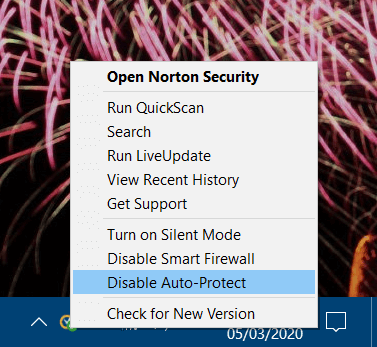
If you discover that the antivirus is causing the problem, then you should consider getting a better antivirus.
- Microsoft might introduce AI-based light-controlling features to Windows
- Windows 11 23H2: How to Download the Official ISO
- A 64-bit Windows 12 ISO is out, theoretically. Here’s all you need to know
- Dev Build 23550 comes with a huge undocumented improvement
- How to enable automatic optional updates in Windows 11
3. Don’t utilize a proxy server
- Click the Type here to search button (with the magnify glass icon) on the taskbar and type proxy.
- Click Proxy settings to open the window in the shot directly below.
- Toggle the Use a proxy server option off.
4. Reset Windows Update
- To do that, enter Command Prompt in the Type here to search box.
- Right-click Command Prompt and choose the Run as administrator option.
- Input these separate commands:
net stop wuauserv net stop cryptSvc net stop bits net stop msiserver
- Open the C: > Windows folder within File Explorer.
- Right-click the SoftwareDistribution subfolder there to select Rename.
- Input SoftwareDistribution.old as the new folder title, and press the Return key.
- Open the System32 folder, which is in the Windows folder.
- Then rename the catroot2 subfolder to Catroot2.old.
- Open an elevated Command Prompt window again.
- Enter these commands to restart the services:
net start wuauserv net start cryptSvc net start bits net start msiserver
- Close the Command Prompt, and restart Windows.
5. Reset the Microsoft Store cache
If you need to fix error 0x8024401f for MS Store app updates, open the Command Prompt as administrator. Then enter this command: wsreset.exe. Press the Return key after entering that command.
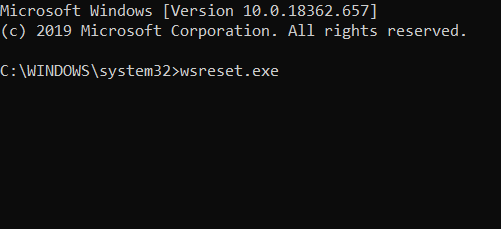
6. Reset your Windows OS
- Type the keyword reset in Windows 10’s search box.
- Click Reset this PC to open the Recovery tab in Settings.
- Click Get started to open Reset this PC.
- Click the Keep my files option.
- Click Next to continue, and press the Reset button.
A few users have also confirmed that resetting Windows 10 can fix error 0x8024401f.
Those are some of the most likely fixes for error 0x8024401f. We would like to know which solutions worked best for you, so leave us your feedback in the form of a message in the comments section below.
- Remove From My Forums
-
Вопрос
-
Hello,
I’ve had to rebuild our WSUS 2012R2 server. Computers and servers are showing up, but not showing how many patches are needed (it’s been days now). If I go to a computer and manually try and run the Windows update I immediately get the error
code:8024401f
Has anyone seen this, maybe there is an issue with IIS in WSUS.
On a computer I see (windowsupdate.log):
2017-04-21 14:34:44:229780
9becWS WARNING: Nws Failure: errorCode=0x803d000f
2017-04-21 14:34:44:229780
9becWS WARNING: There was an error communicating with the endpoint at ‘http://wsus:8530/ClientWebService/client.asmx’.
2017-04-21 14:34:44:229780
9bec WS
WARNING: The server returned HTTP status code ‘500 (0x1F4)’ with text ‘Internal Server Error’.
2017-04-21 14:34:44:229780
9bec WS
WARNING: The server was unable to process the request.
2017-04-21 14:34:44:229780
9bec WS
WARNING: MapToSusHResult mapped Nws error 0x803d000f to 0x8024401f
2017-04-21 14:34:44:229780
9bec WS WARNING: Web service call failed with hr = 8024401f.-
Изменено
21 апреля 2017 г. 15:42
-
Изменено
Ответы
-
Built a Windows 2016 WSUS server and everything works now.
-
Предложено в качестве ответа
Anne HeMicrosoft contingent staff
27 апреля 2017 г. 11:23 -
Помечено в качестве ответа
TB303
2 мая 2017 г. 14:07
-
Предложено в качестве ответа
Сообщение с ошибкой 0x8024401f появляется при установке обновлений Wndows. Она означает, что в серверном наборе Internet Information Services (IIS) возник сбой во время обработки запроса на загрузку файлов апдейтов. Чаще всего ошибка возникает при обновлении не с общедоступных серверов Microsoft, а с хранилищ внутри рабочих сетей
Как исправить ошибку 0x8024401f?
Решается неисправность следующими методами:
- Убедитесь, что внутри IIS нет дублей MIME-типов. Для этого обратитесь к администратору корпоративной сети, чтобы он удалил все дубликаты. Рекомендуем приложить к этому скриншот с ошибкой — в развернутом виде там должны быть указаны, касательно каких именно MIME-типов есть лишние копии.
- Проверьте, что рабочий ПК имеет доступ к корпоративному серверу WSUS. Для этого введите в адресную строку стандартного Проводника ОС следующий адрес и перейдите по нему: \\ххх\WsusContent, где ххх — обозначение сервера WSUS рабочей сети. Если это не увенчалось успехом, то необходимо обратиться к администратору с просьбой о предоставлении соответствующего доступа. Если же ресурс доступен, но ошибка не исчезает, то опять не обойтись без администратора сети. Пусть он запустит на сервере через Командную строку запрос C:\Program Files\Update Services\Tools\wsusutil reset. Далее на проблемном ПК в Командной строке под правами администратора нужно ввести запрос run net stop wuauserv, и подтвердить выполнение действия нажатием на Enter. После перегрузки ОС это должно устранить ошибку 0x8024401f.
Some Windows users have been reaching us with questions after being unable to update their OS build to the latest version available. Most users are reporting that they see the error message 0x8024401f after they click the Check for Updates button. Other users are encountering this issue while trying to update a UWP app via the Windows Store. As it turns out, the issue is not exclusive to a certain Windows version as it’s confirmed to appear on Windows 7, Windows 8.1 and Windows 10.
What is causing the Windows Update error 0x8024401f?
We investigated this particular by analyzing various user reports and by trying out different fixes that other users in a similar situation have successfully deployed to fix this particular problem. As it turns out, this error code can be caused by a collection of different culprits. Here’s a shortlist of scenario in which the 0x8024401f error code might occur:
- 3rd party security interference – An overprotective suite can also be responsible for this particular error code. Sophos, McAfee and a couple of others are potential suspects that are commonly pointed out as culprits that will trigger this behavior. If this scenario is applicable, you can fix the issue entirely bu disabling the real-time protection while installing the update or by uninstalling the security suite altogether.
- Bad Windows update – There are a couple of bad Windows updates with the potential of introducing this particular error. Fortunately, Microsoft has released a hotfix for this issue several weeks after the problem was first introduced. To take advantage of it, simply run the Windows Update troubleshooter and apply the recommended hotfix.
- Corrupted Windows Store cache – If you’re seeing this particular error code while trying to update a UWP application, chances are you’re dealing with a corrupted Windows Store cache. If this scenario is applicable, you will be able to resolve the issue by resetting the Windows Store cache. You can do this either via the Windows GUI or via a CMD terminal.
- Interfering Proxy or VPN connection – A private connection maintained via a proxy server or a VPN solution might prompt the Windows installation agent to determined that your connection is unsafe and refuse to update through the official channels. In this case, you can eliminate the security roadblocks and allow the installation to take place by disabling/ uninstalling the Proxy server or VPN client.
If you’re currently struggling to resolve the very same 0x8024401f error code, this article will provide you with a couple of different repair strategies that you can use to troubleshoot the issue away. Down below. you’ll find several different methods that have been confirmed to be effective by other affected users.
To remain as efficient as possible, we advise you to follow the potential fixes below in the same order that they are arranged in. To make the whole process as efficient as possible, we arranged the methods based on difficulty and efficiency. Eventually, you should stumble upon a fix that will fix the problem regardless of the culprit responsible for the error.
Method 1: Disabling / Uninstalling 3rd party AV
One of the most probable causes that will trigger the 0x8024401f error code when trying to install a pending Windows update is an overprotective AV suite. Sophos, McAfee, AVAST, Comodo and a couple of other 3rd party security suite we’re singled out by affected users as being responsible for this issue.
If this scenario is applicable, you will be able to resolve the issue by either disabling the real-time protection of the AV or by uninstalling it all together and revert to the default security program (Windows Defender).
If you’re currently using a 3rd party suite and you’re suspecting that it might be responsible for the apparition of the 0x8024401f error code, you should start by disabling the real-time protection. Of course, the steps of this procedure will be different depending on which AV suite you’re using, but you can typically do it directly from the taskbar context menu.
If disabling the real-time protection didn’t resolve the issue for you, it doesn’t mean that the issue is not being caused by an overprotective AV suite. Certain security solutions (particularly ones that include a Firewall) will maintain some security suites even in those instances where the user disables the real-time protection.
With this in mind, the only way to ensure that the issue is not being caused by a 3rd party suite is to uninstall the program altogether and follow the steps necessary to ensure that you’re not leaving behind any leftover files. If you decide to go the radical route, you can follow this article (here) to completely uninstall your AV suite without leaving behind any leftover files.
Once you remove the 3rd party AV, restart your computer and see if the issue is resolved at the next system startup. If the 0x8024401f error code is still occurring when you try to install a pending update, move down to the next method below.
Method 2: Running the Windows Update troubleshooter
As it turns out, if the issue was introduced by another bad Windows Update, chances are your OS is capable of resolving the issue automatically. On Windows 10, Microsoft has released a hotfix for this particular issue via an automated repair strategy included inside the Windows Update troubleshooter.
Several users that were also struggling to resolve the 0x8024401f error code have reported that the issue was resolved entirely after they ran the Windows Update troubleshooter. For some of them, this procedure ended up fixing the problem automatically.
The Windows Update troubleshooter is a built-in utility that contains a wide selection of repair strategies that will be enforced automatically if a covered problem is identified. Here’s a short guide on running the Windows Update troubleshooter:
- Press Windows key + R to open up a Run dialog box. Next, type “ms-settings:troubleshoot” and press Enter to open up the Troubleshooting tab of the Settings app.
Opening the Troubleshooting tab of the Settings app via a Run box - Once you’re inside the Troubleshooting tab, move your mouse cursor to the right-hand section of the screen and navigate to the Get up and running section. When you get there, click on Windows Update, then click on Run the troubleshooter.
Running Windows Update Troubleshooter - Once the utility is started, wait patiently until the initial scan is complete. This process will determine whether any of the repair strategies included with the utility apply to the problem that you’re dealing with.
Detecting problem with Windows Update - If a suitable fix is identified, you will be presented with a window in which you can click on Apply this Fix to enforce the repair strategy. Depending on the type of fix, you might need to follow some additional steps to enforce the repair strategy.
Apply this fix - Once the fix is enforced, restart your computer once again and see if the issue is resolved at the next system startup.
If the same 0x8024401f error code is still occurring, move down to the next method below.
Method 3: Resetting the Windows Store cache
If you’re encountering the 0x8024401f error code while trying to update a UWP (Universal Windows Platform) app via Windows Store, chances are the updating process is being stopped by some degree of corrupted system files.
After looking at various occurrences of this kind, it seems like in most cases, the issue appears after a security scanner ends up quarantining some items essential to the updating process. Another possible scenario is a botched update that ended up botching the installation of the new Microsoft Store version.
Several users that were also encountering this issue have reported that they managed to fix the 0x8024401f error by resetting Windows Store and all associated components.
There are two ways of resetting the Windows Store cache on Windows 10. Even though the first option is quicker, it involves doing things from a CMD terminal. If you’re not confident with the CMD terminal or using commands to get the job done, then the second option might be more appealing since it allows you to perform the whole operation from the Windows GUI.
Feel free to follow whichever method you feel more comfortable with:
Resetting Windows Store cache via CMD
- Press Windows key + R to open up a Run dialog box. Next, type ‘cmd’ inside the text box and press Ctrl + Shift + Enter to open up a Command Prompt with administrative privileges. When prompted by the UAC (User Account Control), click Yes to grant admin access.
Running Command Prompt as an administrator - Once you’re inside the elevated Command Prompt, type the following command and hit Enter to reset Windows Store along with all dependencies:
wsreset.exe
Resetting Windows Store - After the command is processed successfully, restart your computer and see if the issue is being resolved at the next system startup.
Resetting the Windows Store cache via the Settings app
- Open a Run dialog box by pressing Windows key + R. Then, type “‘ms-settings:appsfeatures” and press Enter to open up the Apps & Features menu of the Settings app.
- Once you’re inside the App & Features screen, scroll down through the list of installed UWP applications and locate the Microsoft Store entry.
- After you manage to find the correct application, click on the Advanced options hyperlink associated with it (under Microsoft Corporation).
- Once you’re inside the Advanced options menu of the Microsoft Store, scroll down to the Reset tab and click on the Reset button to initiate the process of clearing the cache.
- Wait until the process is complete, then reboot your machine and see if the issue is resolved at the next system startup.
If you’re still encountering the 0x8024401f error code even after resetting the cache of Windows Store, move down to the next method below.
Method 4: Disabling Proxy server VPN client (if applicable)
If you’ve come this far without a result and you’re using a proxy server or a VPN solution to maintain your surfing anonymity, chances are your proxy/VPN is conflicting with the Windows Update client. You may be encountering the 0x8024401f error code because the Windows installation agent does not trust your private connection, so the update is never allowed to be installed.
If this scenario applies to your current scenario, you will be able to resolve the issue by disabling/ uninstalling the Proxy server or VPN client. After doing this and restarting your computer, the installation agent will have no reason not to trust your connection and will allow the Windows/ app update to be installed.
Depending on if you’re using a Proxy server or a VPN client, follow the guide applicable towards stopping the private connection:
Disabling the Proxy Server
- Press Windows key + R to open up a Run dialog box. Next, type “ms-settings:network-proxy” inside the text box and press Enter to open up the Proxy tab of the Network & Internet settings menu.
Opening the Proxy menu via a Run command - Once you’re inside the proxy menu, move to the right section of the screen, then scroll down to Manual Proxy Setup.
- When you arrive at the Manual proxy setup section, simply disable the toggle associated with Use a proxy server.
Disabling the use of a proxy server - Restart your computer and see if the error is resolved at the next system startup.
Uninstalling the VPN client
- Open a Run dialog box by pressing Windows key + R. Then, type “appwiz.cpl’ and press Enter to open up the Programs and Features window.
Type appwiz.cpl and Press Enter to Open Installed Programs List - Once you’re inside the Programs and Features screen, scroll down through the list of installed applications and locate the 3rd party VPN client solution that you’re currently using. When you see it, right-click on it and choose Uninstall from the context menu.
Uninstalling a VPN tool - From the uninstallation screen, follow the on-screen prompt to complete the uninstallation, then restart your computer and see if the issue has been resolved at the next system startup.
 any one can help
any one can help